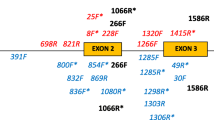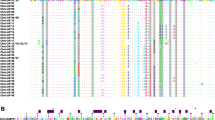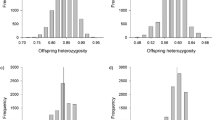Abstract
The great polymorphism observed in the major histocompatibility complex (MHC) genes is thought to be maintained by pathogen-mediated selection possibly combined with MHC-disassortative mating, guided by MHC-determined olfactory cues. Here, we partly characterize the MHC class I and II B of the blue petrel, Halobaena caerulea (Procellariiformes), a bird with significant olfactory abilities that lives under presumably low pathogen burdens in Subantarctica. Blue petrels are long-lived, monogamous birds which suggest the necessity of an accurate mate choice process. The species is ancestral to songbirds (Passeriformes; many MHC loci), although not to gamefowls (Galliformes; few MHC loci). Considering the phylogenetic relationships and the low subantarctic pathogen burden, we expected few rather than many MHC loci in the blue petrel. However, when we analysed partial MHC class I and class II B cDNA and gDNA sequences we found evidence for as many as at least eight MHC class I loci and at least two class II B loci. These class I and II B sequences showed classical MHC characteristics, e.g. high nucleotide diversity, especially in putative peptide-binding regions where signatures of positive selection was detected. Trans-species polymorphism was found between MHC class II B sequences of the blue petrel and those of thin-billed prion, Pachyptila belcheri, two species that diverged ∼25 MYA. The observed MHC allele richness in the blue petrel may well serve as a basis for mate choice, especially since olfactory discrimination of MHC types may be possible in this species.





Similar content being viewed by others
References
Aeschlimann PB, Haeberli MA, Reusch TBH, Boehm T, Milinski M (2003) Female sticklebacks Gasterosteus aculeatus use self-reference to optimize MHC allele number during mate selection. Behav Ecol Sociobiol 54:119–126
Anisimova M, Nielsen R, Yang Z (2003) Effect of recombination on the accuracy of the likelihood method for detecting positive selection at amino acid sites. Genetics 164:1229–1236
Balakrishnan CN, Ekblom R, Voelker M, Westerdahl H, Godinez R, Kotkiewicz H, Burt DW, Graves T, Griffin DK, Warren WC, Edwards SV (2010) Gene duplication and fragmentation in the zebra finch major histocompatibility complex. BMC Biology 8:Article No.: 29
Bang BG, Cobb S (1968) The size of the olfactory bulb in 108 species of birds. Auk 85:55–61
Barbosa A, Palacios MJ (2009) Health of Antarctic birds: a review of their parasites, pathogens and diseases. Polar Biol 32:1095–1115
Benson DA, Karsch-Mizrachi I, Lipman DJ, Ostell J, Wheeler DL (2008) GenBank. Nucleic Acids Res 36:D25–D30
Bernatchez L, Landry C (2003) MHC studies in nonmodel vertebrates: what have we learned about natural selection in 15 years? J Evol Biol 16:363–377
Bollmer JL, Dunn PO, Whittingham LA, Wimpee C (2010) Extensive MHC class II B gene duplication in a passerine, the common yellowthroat (Geothlypis trichas). J Hered 101:448–460
Bonadonna F, Mardon J (2010) One house two families: petrel squatters get a sniff of low-cost breeding opportunities. Ethology 116:176–182
Bonadonna F, Nevitt GA (2004) Partner-specific odor recognition in an Antarctic seabird. Science (Washington D C) 306:835
Bonadonna F, Villafane M, Bajzak C, Jouventin P (2004) Recognition of burrow's olfactory signature in blue petrels, Halobaena caerulea: an efficient discrimination mechanism in the dark. Anim Behav 67:893–898
Bonadonna F, Caro S, Jouventin P, Nevitt GA (2006) Evidence that blue petrel, Halobaena caerulea, fledglings can detect and orient to dimethyl sulfide. J Exp Biol 209:2165–2169
Bonneaud C, Sorci G, Morin V, Westerdahl H, Zoorob R, Wittzell H (2004) Diversity of Mhc class I and IIB genes in house sparrows (Passer domesticus). Immunogenetics 55:855–865
Bonneaud C, Chastel O, Federici P, Westerdahl H, Sorci G (2006) Complex MHC-based mate choice in a wild passerine. Proc R Soc Biol Sci B 273:1111–1116
Bos DH, Waldman B (2006) Polymorphism, natural selection, and structural modeling of class Ia MHC in the African clawed frog (Xenopus laevis). Immunogenetics 58:433–442
Brooke M (2004) Albatrosses and petrels across the world. Oxford University Press Inc., New York
Brown JL (1997) A theory of mate choice based on heterozygosity. Behav Ecol 8:60–65
Brown RE, Singh PB, Roser B (1987) The major histocompatibility complex and the chemosensory recognition of individuality in rats. Physiol Behav 40:65–74
Brown RE, Roser B, Singh PB (1989) Class I and class II regions of the major histocompatibility complex both contribute to individual odors in congenic inbred strains of rats. Behav Genet 19:659–674
Brown JH, Jardetzky TS, Gorga JC, Stern LJ, Urban RG, Strominger JL, Wiley DC (1993) Three-dimensional structure of the human class II histocompatibility antigen HLA-DR1. Nature (London) 364:33–39
Chaix R, Cao C, Donnelly P (2010) Is mate choice in humans MHC-dependent? PLoS Genetics 6:Article No.: e1000184
Chenna R, Sugawara H, Koike T, Lopez R, Gibson TJ, Higgins DG, Thompson JD (2003) Multiple sequence alignment with the Clustal series of programs. Nucleic Acids Res 31:3497–3500
Cherel Y, Bocher P, Trouve C, Weimerskirch H (2002) Diet and feeding ecology of blue petrels Halobaena caerulea at Iles Kerguelen, Southern Indian Ocean. Mar Ecol Prog Ser 228:283–299
Doherty PC, Zinkernagel RM (1975) A biological role for the major histo compatibility antigens. Lancet 1:1406–1409
Ekblom R, Saether SA, Grahn M, Fiske P, Kalas JA, Hoglund J (2004) Major histocompatibility complex variation and mate choice in a lekking bird, the great snipe (Gallinago media). Mol Ecol 13:3821–3828
Felsenstein J (1985) Confidence limits on phylogenies and approach using the bootstrap. Evolution 39:783–791
Freeman-Gallant CR, Meguerdichian M, Wheelwright NT, Sollecito SV (2003) Social pairing and female mating fidelity predicted by restriction fragment length polymorphism similarity at the major histocompatibility complex in a songbird. Mol Ecol 12:3077–3083
Gillingham MAF, Richardson DS, Lovlie H, Moynihan A, Worley K, Pizzari T (2009) Cryptic preference for MHC-dissimilar females in male red junglefowl, Gallus gallus. Proc R Soc Biol Sci B 276:1083–1092
Hackett SJ, Kimball RT, Reddy S, Bowie RCK, Braun EL, Braun MJ, Chojnowski JL, Cox WA, Han K-L, Harshman J, Huddleston CJ, Marks BD, Miglia KJ, Moore WS, Sheldon FH, Steadman DW, Witt CC, Yuri T (2008) A phylogenomic study of birds reveals their evolutionary history. Science (Washington D C) 320:1763–1768
Havlicek J, Roberts SC (2009) MHC-correlated mate choice in humans: a review. Psychoneuroendocrinology 34:497–512
Hess CM, Edwards SV (2002) The evolution of the major histocompatibility complex in birds. Bioscience 52:423–431
Janeway CAJ, Travers P, Walport M, Shlomchik MJ (2001) Immunobiology, the immune system in health and disease. Garland Science, New York
Jeffery KJM, Bangham CRM (2000) Do infectious diseases drive MHC diversity? Microbes Infect 2:1335–1341
Jordan WC, Bruford MW (1998) New perspectives on mate choice and the MHC. Heredity 81:127–133
Kaufman J, Voelk H, Wallny H-J (1995) A "minimal essential MHC" and an "unrecognized MHC": two extremes in selection for polymorphism. Immunol Rev 143:63–88
Kaufman J, Milne S, Goebel TWF, Walker BA, Jacob JP, Auffray C, Zoorob R, Beck S (1999) The chicken B locus is a minimal essential major histocompatibility complex. Nature (London) 401:923–925
Kikkawa EF, Tsuda TT, Sumiyama D, Naruse TK, Fukuda M, Kurita M, Wilson RP, LeMaho Y, Miller GD, Tsuda M, Murata K, Kulski JK, Inoko H (2009) Trans-species polymorphism of the Mhc class II DRB-like gene in banded penguins (genus Spheniscus). Immunogenetics 61:341–352
Kimura M (1980) A simple method for estimating evolutionary rates of base substitutions through comparative studies of nucleotide sequences. J Mol Evol 16:111–120
Klein J, Bontrop RE, Dawkins RL, Erlich HA, Gyllensten UB, Heise ER, Jones PP, Parham P, Wakeland EK, Watkins DI (1990) Nomenclature for the major histocompatibility complexes of different species: a proposal. Immunogenetics 31:217–219
Mardon J, Bonadonna F (2009) Atypical homing or self-odour avoidance? Blue petrels (Halobaena caerulea) are attracted to their mate’s odour but avoid their own. Behav Ecol Sociobiol 63:537–542
Mardon J, Saunders SM, Anderson MJ, Couchoux C, Bonadonna F (2010) Species, gender, and identity: cracking petrels' sociochemical code. Chem Senses 35:309–321
Mays HL Jr, Hill GE (2004) Choosing mates: good genes versus genes that are a good fit. Trends Ecol Evol 19:554–559
Miller HC, Bowker-Wright G, Kharkrang M, Ramstad K (2011) Characterisation of class II B MHC genes from a ratite bird, the little spotted kiwi (Apteryx owenii). Immunogenetics 63:223–233
Møller AP (1998) Evidence of larger impact of parasites on hosts in the tropics: investment in immune function within and outside the tropics. Oikos 82:265–270
Møller AP, Erritzøe J (1996) Parasite virulence and host immune defense: host immune response is related to nest reuse in birds. Evolution 50:2066–2072
Møller AP, Erritzøe J, Saino N (2003) Seasonal changes in immune response and parasite impact on hosts. Am Nat 161:657–671
Moon DA, Veniamin SM, Parks-Dely JA, Magor KE (2005) The MHC of the duck (Anas platyrhynchos) contains five differentially expressed class I genes. J Immunol 175:6702–6712
Nei M, Gojobori T (1986) Simple methods for estimating the numbers of synonymous and non synonymous nucleotide substitutions. Mol Biol Evol 3:418–426
Nunn GB, Stanley SE (1998) Body size effects and rates of cytochrome b evolution in tube-nosed seabirds. Mol Biol Evol 15:1360–1371
Olsén KH, Grahn M, Lohm J, Langefors A (1998) MHC and kin discrimination in juvenile Arctic charr, Salvelinus alpinus (L.). Anim Behav 56:319–327
Penhallurick J, Wink M (2004) Analysis of the taxonomy and nomenclature of the Procellariiformes based on complete nucleotide sequences of the mitochondrial cytochrome b gene. Emu 104:125–147
Penn DJ (2002) The scent of genetic compatibility: sexual selection and the major histocompatibility complex. Ethology 108:1–21
Penn D, Potts W (1998) How do major histocompatibility genes influence odor and mating preferences? Adv Immunol 69:411–435
Penn DJ, Potts WK (1999) The evolution of mating preferences and major histocompatibility complex genes. Am Nat 153:145–164
Piersma T (1997) Do global patterns of habitat use and migration strategies co-evolve with relative investments in immunocompetence due to spatial variation in parasite pressure? Oikos 80:623–631
Richardson DS, Westerdahl H (2003) MHC diversity in two Acrocephalus species: the outbred Great reed warbler and the inbred Seychelles warbler. Mol Ecol 12:3523–3529
Richardson DS, Komdeur J, Burke T, von Schantz T (2005) MHC-based patterns of social and extra-pair mate choice in the Seychelles warbler. Proc R Soc Biol Sci B 272:759–767
Saitou N, Nei M (1987) The neighbor-joining method a new method for reconstructing phylogenetic trees. Mol Biol Evol 4:406–425
Sambrook J, Fritsch EF, Maniatis T (1989) Molecular cloning a laboratory manual, 2nd edn. Cold Spring Harbor Laboratory, Cold Spring Harbor
Sanger F, Nicklen S, Coulson AR (1977) DNA sequencing with chain terminating inhibitors. Proc Natl Acad Sci U S A 74:5463–5467
Shiina T, Shimizu S, Hosomichi K, Kohara S, Watanabe S, Hanzawa K, Beck S, Kulski JK, Inoko H (2004) Comparative genomic analysis of two avian (quail and chicken) MHC regions. J Immunol 172:6751–6763
Sibley CG, Ahlquist JE (1990) Phylogeny and classification of birds: a study in molecular evolution. Yale University Press, New Haven
Silva MC, Edwards SV (2009) Structure and evolution of a new avian MHC class II B gene in a sub-Antarctic seabird, the thin-billed prion (Procellariiformes: Pachyptila belcheri). J Mol Evol 68:279–291
Sitte K, Brinkworth R, East IJ, Jazwinska EC (2002) A single amino acid deletion in the antigen binding site of BoLA-DRB3 is predicted to affect peptide binding. Vet Immunol Immunopathol 85:129–135
Tamura K, Dudley J, Nei M, Kumar S (2007) MEGA4: molecular evolutionary genetics analysis (MEGA) software version 4.0. Mol Biol Evol 24:1596–1599
Tregenza T, Wedell N (2000) Genetic compatibility, mate choice and patterns of parentage: invited review. Mol Ecol 9:1013–1027
Wallny H-J, Avila D, Hunt LG, Powell TJ, Riegert P, Salomonsen J, Skjodt K, Vainio O, Vilbois F, Wiles MV, Kaufman J (2006) Peptide motifs of the single dominantly expressed class I molecule explain the striking MHC-determined response to Rous sarcoma virus in chickens. Proc Natl Acad Sci U S A 103:1434–1439
Warham J (1996) The behaviour, population biology and physiology of the petrels. Academic Press, London
Weimerskirch H, Zotier R, Jouventin P (1989) The avifauna of the Kerguelen islands Indian ocean. Emu 89:15–29
Westerdahl H (2004) No evidence of an MHC-based female mating preference in great reed warblers. Mol Ecol 13:2465–2470
Westerdahl H, Wittzell H, Von Schantz T (1999) Polymorphism and transcription of Mhc class I genes in a passerine bird, the great reed warbler. Immunogenetics 49:158–170
Westerdahl H, Wittzell H, von Schantz T (2000) Mhc diversity in two passerine birds: no evidence for a minimal essential MHC. Immunogenetics 52:92–100
Westerdahl H, Wittzell H, von Schantz T, Bensch S (2004) MHC class I typing in a songbird with numerous loci and high polymorphism using motif-specific PCR and DGGE. Heredity 92:534–542
Yamazaki K, Boyse EA, Mike V, Thaler HT, Mathieson BJ, Abbott J, Boyse J, Zayas ZA, Thomas L (1976) Control of mating preferences in mice by genes in the major histo compatibility complex. J Exp Med 144:1324–1335
Yamazaki K, Yamaguchi M, Baranoski L, Bard J, Boyse EA, Thomas L (1979) Recognition among mice: evidence from the use of a Y-maze differentially scented by congenic mice of different major histocompatiblity types. J Exp Med 150:755–760
Yang Z (2006) Computational molecular evolution. Oxford University Press, New York
Yang Z (2007) PAML 4: phylogenetic analysis by maximum likelihood. Mol Biol Evol 24:1586–1591
Yang Z, Wong WSW, Nielsen R (2005) Bayes empirical Bayes inference of amino acid sites under positive selection. Mol Biol Evol 22:1107–1118
Zelano B, Edwards SV (2002) An MHC component to kin recognition and mate choice in birds: predictions, progress, and prospects. Am Nat 160:S225–S237
Acknowledgements
This work was supported by the Institut Polaire Francais Paul-Emile Victor (IPEV programme ETHOTAAF no. 354 to FB), and the Agence Nationale de la Recherche Francaise (AMBO ANR-08-BLAN-0117-01 to FB). All aspects of the study were performed according to guidelines established by the IPEV and the CNRS for the ethical treatment of animals and complied with current French regulations. We are grateful to Jerome Mardon, Aurore Malapert and all the field workers who helped through the programme ETHOTAAF over the years. Many thanks to Marie-Pierre Dubois at CEFE, Montpellier and the ecological MHC group in Lund.
Author information
Authors and Affiliations
Corresponding author
Electronic supplementary materials
Below is the link to the electronic supplementary material.
Supplementary Fig. 1
Phylogenetic tree of major histocompatibility complex class I exons 2–4 translated sequences (Haca-UA*xxL, GenBank accession numbers, Acc nr JF276877–JF276884) from the blue petrel, Halobaena caerulea, five other bird species (Acc nr and species codes are given: Grca Grus canadensis pratensis, Anan Anser anser, Anpl Anas platyrhynchos, Gaga Gallus gallus and Acar Acrocephalus arundinaceus). Human HLA-A (Hosa_NM002116) was used as outgroup. Neighbour-joining bootstrap consensus tree from 2,000 replicates (Felsenstein 1985; Saitou and Nei 1987) constructed in MEGA4 (Tamura et al. 2007). Filled squares/circles represent sequences from each of two blue petrel individuals (PDF 386 kb)
Supplementary Fig. 2
Amino acid alignment of major histocompatibility complex class I exon 3 translated sequences (Haca-UA*01-Haca-UA*45, Acc nr JF276832–JF276876) from the blue petrel, Halobaena caerulea, five other bird species (Acc nr and species codes are given: Grca Grus canadensis pratensis, Anan Anser anser, Anpl Anas platyrhynchos, Gaga Gallus gallus, Acar Acrocephalus arundinaceus) and human HLA-A (Hosa_NM002116). Peptide-binding regions were inferred (a pocket a, f pocket f, c other peptide contacts, t t-cell contacts) (Wallny et al. 2006). Positively selected amino acid sites (plus sign) identified with model 8 in CODEML, PAML (Yang 2007) (PDF 33 kb)
Supplementary Fig. 3
Southern blots of major histocompatibility complex (MHC) probes hybridized to Pvu II cleaved genomic DNA from four individuals of blue petrels, Halobaena caerulea. Each lane represents an individual (1–4). The left panel shows a MHC class I exon 3 probed blot and the right panel a MHC class II B exon 2 probed blot of the same four individuals (PDF 323 kb)
Supplementary Fig. 4
Amino acid alignment of major histocompatibility complex class II B exon 2 translated sequences (Haca-DAB*01-Haca-DAB*08, Acc nr JF276885–JF276892) from the blue petrel, Halobaena caerulea, and the thin-billed prion, Pachyptila belcheri (Pabe, Acc nr are given). Peptide-binding regions were inferred (c peptide contacts) (Brown et al. 1993). Positively selected amino acid sites (plus sign) identified with model 8 in CODEML, PAML (Yang 2007) (PDF 31 kb)
Supplementary Table 1
Major histocompatibility alleles (class I Haca-UA, class II B Haca-DAB, L long sequences, GenBank Acc nr JF276832–JF276894) identified by sequencing MHC clones from 25 blue petrel, Halobaena caerulea, individuals (1–25; g genomic DNA, c cDNA) (DOC 157 kb)
Rights and permissions
About this article
Cite this article
Strandh, M., Lannefors, M., Bonadonna, F. et al. Characterization of MHC class I and II genes in a subantarctic seabird, the blue petrel, Halobaena caerulea (Procellariiformes). Immunogenetics 63, 653–666 (2011). https://doi.org/10.1007/s00251-011-0534-8
Received:
Accepted:
Published:
Issue Date:
DOI: https://doi.org/10.1007/s00251-011-0534-8




